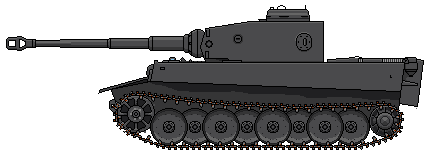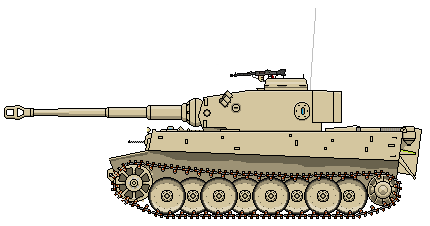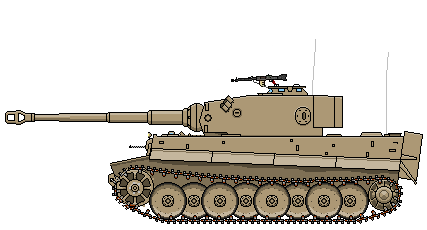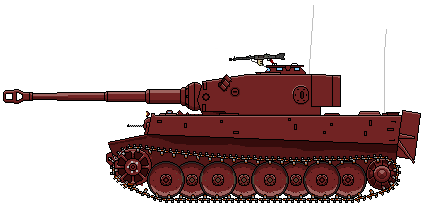Panzerkampfwagen VI "Tiger"
Boxy old bastard
Tiger is usually seen as the definitive German tank, even at the time - even if it was the Last of the Boxy Tanks. Allied soldiers would report meeting "Tigers" when they actually saw a Panzer IV and there were no Tigers for miles around. It does have a certain presence and a fantastic gun, but it was also difficult, sensitive and expensive. But as a weapon, Panther was much more advanced and user-friendly, but then Tiger did have a better field manual. Not a lot of them were built, too - 1350 of them, versus 8550 Panzer IVs, 49200 Shermans and 84000 T-34s. So meeting one in the wild was going to be a chance encounter - one you'd best run away from if you didn't drive a Firefly or a IS-2.
Even though its startup phase was a bit difficult (The Soviets captured the literally first one in action, and the British caught number 131 in Tunisia, the vehicle is a legend. In fact, ask a child to draw a tank. It will probably look like one. Which is why, when my baby daughter was afraid of the dark, I 'taught' her two stuffed animals (Ostuf Fluffy and Schütze Beertje) to drive my R/C Tiger, so they could fight off the monsters under her bed. They did, and she slept like a log.

VK4501-H
The roots of the Tiger tank go back to 1937, which is why it's boxy, but only after the T-34 scare was the design pushed through. "Let's take an armoured box", they thought, "and put one of those 8,8s in it." Entirely reasonable, that gun was magnificent. Two versions were offered: one by Henschel and the other by Porsche. The Henschel version won, even if a lot of development was needed.
- RAL7016
- 8,8cm KwK36 L/56
- Maybach HL210 TRM P45
- No track guards
- Vorpanzer armoured front shield

Sd.Kfz.181 / PzKpfw VI Ausf. H1
When the Tigers were first used (in Mga, USSR), they did not yet have turret bustles. The crews needed tools a lot, as these machines would break down a lot. In fact, the first Tiger in use was easily captured by the Soviets after its transmission caught fire. They say that the Soviets were not very impressed (but I tend not to believe Russian statements post 2012).
- Feifel air cleaners
- Turret bustle as standard
- Track guards and mud flaps
- No more Vorpanzer
- This one is in RAL8002, for the Afrikakorps

PzKpfw VI Ausf. E (Early)
Even if it was a previous generation tank, it was the pinnacle of that generation. In the hands of an experienced tanker, Tiger was a legend that ruled the battlefield. Well, psyschologically. In the west, the Allies tended to run away from anything Tiger-shaped and call in the artillery or a couple of rocket-armed Typhoons or P-47s. In the East, being scared of the facist invaders was not allowed so they just kept spamming the things with T-34s.
- RAL7028 DGnM I '44
- New oval Feifels, if any were fitted
- Maybach HL230 engine
- Updated turret with domed cupola
- Zimmerit paste

PzKpfw VI Ausf. E (Late)
Tiger tanks were specialist vehicles, requiring a very-well trained crew (and mainly driver, or the engine wouldn't last a week). It had one of the best guns of the war, thick (and expensive) armour and a terrifying reputation. However, they were often overkill: in most cases, a Panther of Panzer IV-G would work just as well. But Germans being Germans, they just had to have their heavy machinery. The vehicle was "simplified" - for example, the steel road wheels should have been usable on the Panther and King Tiger, but they weren't, complicating the situation even further.
- RAL8012 primer base coat
- No more Feifel air cleaners
- No travel lock for the gun (bad idea!)
- Steel road wheels
- Monocular gun sight (for better depth perception, huhuh)
- Wooden deck over the fuel tanks